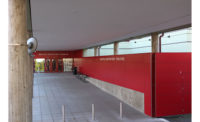The keypad has been a fixture of the access control world for a long time. The first pushbutton combination lock is credited to Alfred A. Peters in 1875. And since then, they have been a popular — and often a more affordable — option for securing doors when a customer doesn’t want to keep track of keys or cards.
Like any technology in today’s digital world, however, the access control keypad has evolved with the times and is hardly sitting around waiting to be obsoleted by futuristic technologies such as biometrics or mobile credentials. From a growing use in residential and multi-family dwellings, to an introduction of more aesthetic designs, new form factors and multi-functionality, the keypad can be the best fit for a variety of applications.
SDM spoke with four manufacturers about recent trends in keypad technology and usage: Bryan Sanderford, national sales manager, Dortronics Systems Inc., Sag Harbor, N.Y.; Scott Morstatt, product manager for keypad locks and multi-family solutions, ASSA ABLOY, New Haven, Conn.; David Price, marketing manager, Camden Door Controls, Mississauga, Ontario, Canada; and Adam Kinder, access control manager, Digital Monitoring Products (DMP), Springfield, Mo.
SDM: What is new with access control keypads?
Kinder: Access control keypads have shifted from single use, keypad-only methods to combination units with proximity and smart card technologies. In addition, we have recently begun tying keypads to the cloud environment, which gives users the flexibility to manage access control from wherever they are, or dealers the opportunity to increase RMR. It’s the same keypads that we have used and had for a long time … it’s the cloud environment that is new.
Price: We’re seeing keypads with more operating modes, so now an installer can select one model for standalone, Wiegand and/or wireless. Previously, installers needed to stock multiple keypad models, but now they can stock one that can be used in a wide range of applications. Additionally, while the selection of “universal” keypad models has increased, the costs have continued to decrease.
Morstatt: We’re seeing a few trends evolving. One is a strong acceptance in residential applications. People are simply more comfortable with this technology in their home. They’re enjoying the convenience of not carrying keys. We’re also seeing less cylinder override with a mechanical key. This “key-free” trend is moving into commercial, so we can see that trends from the residential space — and people’s expectations there — are affecting both sides. Without the need for a cylinder, the form factor can also be much smaller. As a result, keypads, which used to be very utilitarian in nature, are now seeing the benefits of good design and aesthetics.
SDM: Has their purpose shifted? Are they still a popular option for doors? What about other uses?
Sanderford: Maintaining the highest level of security requires ensuring that individuals may only have access to the specific areas they are authorized to enter, and keypads can be used as the primary access mechanism or in conjunction with some other form of access control like a card or proximity reader for multi-factor authentication. And while door access is the primary application for keypads, they are increasingly being used for other security applications like security lockers.
Morstatt: Their popularity has exploded. What we’re seeing with keypads is that it is a soft follower of the mobile phone environment. Just like with cell phones, we have moved away from the mechanical pushbutton layouts and are now using sleek black screens with digital keypads. That said, we are also seeing their purpose expand to other areas of a building or vertical. We now see how remote access and audit trails can add capabilities to locks, providing visibility into exactly who accessed a location and at what time. That used to be primarily a commercial use, but with the ability to offer different PIN codes or access components to people, it has expanded to the home environment.
Price: The use of keypads hasn’t shifted; they continue to be a good security option, giving great ease-of-use to end users who don’t require an audit trail and prefer not to give all their employees, or building occupants, cards or key fobs. As an entry-level access control device, keypads continue to be unequaled for simplicity of installation and ease-of-use.
SDM: What technology or end user trends are you seeing in keypads for access control?
Kinder: There are two primary uses for keypads in access control environments. Firstly, they can be used to provide higher security, such as card-plus-PIN configurations. This multi-factor authentication increases security and mitigates risk of losing a card and allowing access. Secondly, many institutions that experience high turnover but have low risk may incorporate keypads for a PIN-only access solution; this reduces the cost of ownership by removing the need for credentials and allows for easy enrollment.
Price: A common trend in keypad design now is the use of keypads with built-in proximity readers; PIN or prox card access gives you the ability to have the best of all possible worlds — a simple PIN code for some people and a card for others, if desired. Keypads offer a low-cost solution for restricting access to a professional business, healthcare or daycare facility. In addition, they are also ideal for restricting access to sensitive or dangerous areas, cabinets or equipment within a facility. They are excellent wherever simplicity and low cost are needed.
Sanderford: Keypads are often used in conjunction with other access control solutions including card/proximity readers and biometric devices to enter a user PIN for enhanced security. This form of multi-factor authentication provides a second layer of security in case an access card is lost, stolen or loaned.
Morstatt: Keypads still are mostly used in commercial access control, and for integrators, that is a stable source of revenue moving forward. But the new growth plan — the rapid growth plan — is in residential and multi-family residential settings. That is because of the ease of access and low cost of access management. We’re also seeing it expand in remote sites for business. For example, a remote cell tower where there is a small utility building is a prime location. You might have different maintenance people going to that site and having a key system for that may not be viable.
For end users, keypad solutions allow for easier access and reduce the burden of carrying keys. For integrators, the simplicity of integration, the ability to offer interconnected devices, and the ability to offer more security on new locations — such as gates or glass doors — means a chance to win more business.













